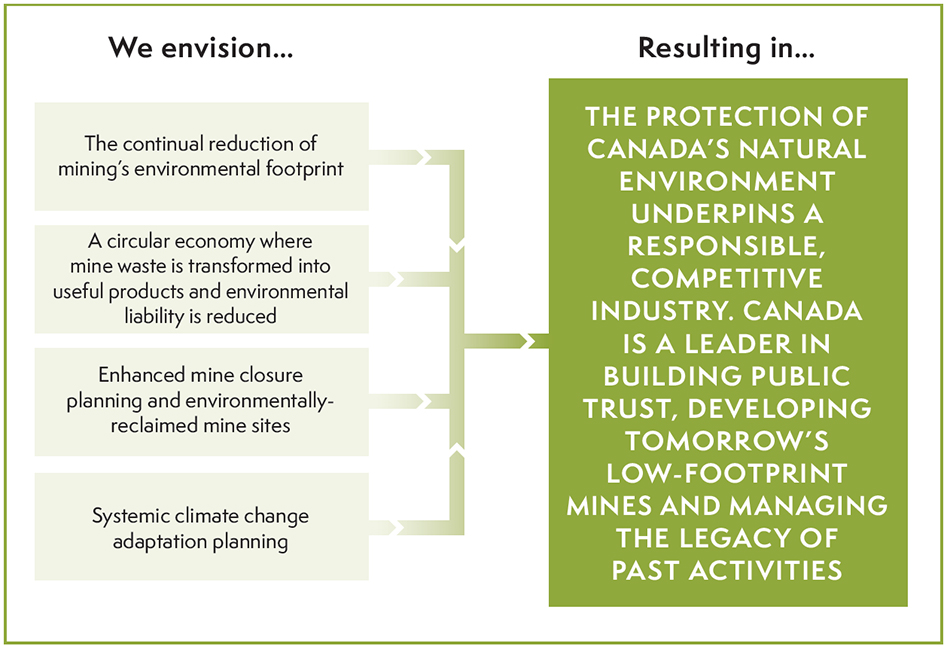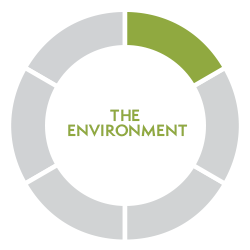The environment

Text Version
We envision …
|
Resulting in … The protection of Canada’s natural environment underpins a responsible, competitive industry. Canada is a leader in building public trust, developing tomorrow’s low-footprint mines and managing the legacy of past activities |
What is the goal of this strategic direction?
- The protection of Canada’s natural environment underpins a responsible, competitive mining industry. Through this strategic direction, the Canadian Minerals and Metals Plan is taking action to solidify Canada as a leader in building public trust, developing tomorrow’s low-footprint mines and managing the legacy of past activities
- Adapt the mining cycle to climate changes
- Further integrate the principles of the circular economy into the mining cycle
- Advance reclamation of legacy mines
- Build public trust in new and existing projects
- Enable innovative practices, including supporting the implementation of alternate and renewable energy
- Develop a pan-Canadian mining value from waste research program

What is the pan-Canadian initiative?
The National Orphaned/Abandoned Mines Initiative (NOAMI) was a national multi-stakeholder committee established in 2002 to address issues related to orphaned and abandoned mines (OAM) sites in Canada (for which respective mining jurisdictions have ultimate responsibility). New and emerging issues regarding mine reclamation and closure warranted re-consideration of its mandate.
NOAMI was dissolved in 2022 after determining that it successfully met its original objectives, including building a national inventory of OAM sites; engaging communities; identifying funding models, ownership and liability issues; and identifying areas where research could help jurisdictions advance reclamation and prevent new occurrences. The important guidance documents that NOAMI produced, as well as the national web-based inventory of OAM will continue to inform the reclamation and closure work that remains at legacy sites across Canada.
Challenges related to reclamation of OAM sites across Canada persist, such as the effects of changing climatic conditions on OAM sites that are largely unknown and add an element of complexity to their management. In place of NOAMI, an annual OAM workshop will be held to facilitate information sharing, diverse and inclusive engagement, and broad collaboration on ongoing challenges related to OAM by bringing governments, practitioners, industry, Indigenous Peoples, environmental non-government organizations, and academics together in one place.
While workshop themes would change on an annual basis to explore and collaborate on different issues, the workshop will focus on one or a few of the following:
- Local communities and Indigenous Peoples engagement and benefits
- Jurisdictional legislative review and financial assurance measures
- Mine design and closure planning / return of mining lands
- Climate change and risk assessment
- Innovation
The 2nd Annual OAM Workshop – October 23-25, 2024
SAVE THE DATE for the 2nd Annual OAM Workshop on October 23-25, 2024, from 12-4 pm ET.
- An open-door event for the public will be held on Thursday, October 24 and Friday, October 25.
- A closed-door event for FPT governments will be held on Wednesday, October 23.
The Workshop will be delivered in hybrid format with the option to attend in-person (in Ottawa) or virtually (via MS Teams).
With the theme of Foundations for Success: Building Capacity and Developing Best Practices, the Workshop will explore topics relevant to successful OAM remediation, including best practices for remediation planning and implementation; creating strong, effective, and inclusive partnerships between various stakeholders; addressing capacity constraints, developing supportive relationships, and providing opportunities to Indigenous partners; and potential economic opportunities and partnerships, such as in the realm of mine waste valorisation, recovery and reprocessing, as well as the examination of associated considerations, risks, and challenges.
We encourage the participation of a wide variety of individuals and organizations interested in the remediation of OAM sites and related issues.
More details and the registration link will be available on this page later this summer.
The 1st Annual OAM Workshop was held on October 11, 12 and 19, 2023.
The theme of this virtual workshop was Targeted Land Use Planning through Collaboration and Innovation and included sessions focused on land use planning and design, collaboration with communities, particularly the historical relationship with Indigenous Peoples, innovative approaches, and environmental considerations.
We saw the participation of a wide variety of public and private stakeholders interested in orphaned and abandoned mine sites and related issues.
Resources from the open-door sessions on October 11 and 12
Some of the information below has been provided by external sources. The Government of Canada is not responsible for the accuracy, reliability or timeliness of the information supplied by external sources. Content provided by external sources is not subject to official languages requirements.
What We Heard Report
- 1st Annual OAM Workshop – What We Heard (PDF, 225 KB)
Presentations
- Day 1, Session 2 – Land Use Planning - Desrosiers (PDF, 725 KB)
- Day 1, Session 2 – Land Use Planning – Viridis Terra (PDF, 3.33 MB)
- Day 1, Session 2 – Land Use Planning – Hainey (PDF, 1.41 MB)
- Day 1, Session 3 – Landform Design – McKenna (PDF, 7.43 MB)
- Day 2, Session 2 – Potential of Innovation – Young&Shang (PDF, 165 KB)
- Day 2, Session 3 – Innovative Approaches – Forde (PDF, 1.79 MB)
- Day 2, Session 3 – Innovative Approaches – Shang (PDF, 1.26 MB)
- Day 2, Session 3 – Innovative Approaches – Tisch (PDF, 1.25 MB)
- Day 2, Session 3 – Innovative Approaches – Deriaz (PDF, 2.81 MB)
- Day 2, Session 4 – Environmental Considerations – Chevalier (PDF, 3.09 MB)
- Day 2, Session 4 – Environmental Considerations – Project CLEANS (PDF, 3.09 MB)
To continue to inform the reclamation and closure work that remains at legacy sites across Canada, the national we-based inventory of OAM can still be accessed online in both official languages at NOAMI.org.
For a copy of one of the following guidance documents produced by NOAMI (in English only, unless otherwise noted), contact us:
- Barriers to Collaboration: Orphaned/Abandoned Mines in Canada
- Canada’s National Orphaned/Abandoned Mines Initiative: The Return of Mining Lands Project and Looking to the Future
- Capacity Building for a National Inventory of Orphaned/Abandoned Mines in Canada
- Case Studies and Decision Making Process for the Relinquishment of Closed Mine Sites
- Key Criteria for the Effective Long-term Stewardship of Closed, Orphaned/Abandoned Mine and Mineral Exploration Sites
- Lessons Learned on Community Involvement in the Remediation of Orphaned and Abandoned Mines – Case Studies and Analysis
- Managing Long-Term Orphaned Mine Liabilities: Exploring the Relinquishment of Closed Sites
- Managing Orphaned and Abandoned Mines – A Canadian Perspective
- NOAMI Performance Report 2002-2008 (English / French)
- NOAMI Performance Report Update 2009-2015 (English / French)
- Orphaned and Abandoned Mines: Risk Identification, Cost Estimation and Long-term Management
- Policy Framework in Canada for Mine Closure and Management of Long-term Liabilities: A Guidance Document
- Potential Funding Approaches for Orphaned/Abandoned Mines in Canada
- Rehabilitating Abandoned Mines in Canada: A Toolkit of Funding Options
- Report on the Legislative, Regulatory, and Policy Framework Respecting Collaboration, Liability, and Funding Measures in relation to Orphaned/Abandoned, Contaminated, and Operating Mines in Canada
Areas for Action
Reducing waste: Provide more targeted support for research and development (R&D), and innovation that reduces the consumption of water and energy in mining and the production of waste rock in mining.
Alternate and renewable energy: Accelerate efforts to develop and adopt clean energy sources, including studying the feasibility of small modular reactors in mining operations.
Circular economy: Study Canada’s recycling and reprocessing capacity and capabilities to determine how they can support sustainability and competitiveness.
Reclaiming mine sites: Collaborate to study and recommend best practices regarding ecosystem rehabilitation plans, improve financial assurance measures, and address environmental and other concerns arising from orphaned/abandoned mines.
Climate change adaption: Encourage industry to plan for and adopt measures to adapt to climate change.
Key actions and resources
To address environmental and other concerns arising from orphaned or abandoned mines:
- Assessment and reclamation of mines (all governments)
- Allow companies to release land back to the Crown through the Institutional Control Program (Sask.)
- Agreements to clean up abandoned sites in northern Quebec (Que.)
- Dam Safety Program to address deficiencies at OAM sites (N.L.)
- Create the Northern Abandoned Mine Reclamation Program (Can.)
- Remediate the eight highest-risk abandoned mine sites in the Y.T. and the N.W.T. (Can.)
- Assess climate-change risks and review rehabilitation plans for OAM sites; identify how rehabilitation plans could integrate adaptation measures (Can.)
- National climate change adaption guidance and sustainable financing standard, being developed by the Mining Association of Canada (MAC) with the financial industry and the Canadian Standards Association (Can., Assoc.)
- MAC’s updated TSM Energy Use and GHG Emissions Management Protocol (Assoc.)
- MAC’s Tailings Management Protocol and TSM Biodiversity Conservation Protocol (Assoc.)
To accelerate efforts to develop and adopt clean energy sources, particularly for northern, remote and isolated communities that rely on diesel:
- R&D for a more energy-efficient process to extract copper (Can., B.C.)
- Expand Nunavik’s first centre for producing and storing renewable energy (Can.)
- R&D for carbon neutral mining at Gahcho Kué Mine (Can.)
- Reduce energy consumption and costs for mechanical compressors at Holloway Mine in Kirkland Lake (Can.)
- Research on hydrogen technology adoption (Can.)
- Achieve zero-footprint mining (Can.)
- Energy efficiency for industry
To support sustainability, keep resources in circulation and minimize discards:
- Clean Resources Innovation Network’s Low Emissions Value Added Products (Alta.)
- Preliminary Canadian Resource Recovery Report Card and Gaps Assessment (Can.)
- MAC member (Teck Resources) using electric buses for employees and solar farms to power operations (Assoc.)
To encourage industry to plan for and adopt measures to adapt to climate change:
- Climate change, energy, and green economy strategy (Y.T.)
- Guidance for assessing and managing climate change risks throughout the mine lifecycle in a northern climate (Y.T., Can.)
- Reducing the negative effects of climate change through adaptation, programs and funding opportunities, and greenhouse gas emissions reduction (Can.)
To study the feasibility of small modular reactors (SMR) in mining operations, as well as the potential market for this technology:
- Commitment for nuclear research (N.B.)
- Memorandum of Understanding among N.B., Ont., and Sask. to develop SMRs (Ont., N.B., Sask.)
- Studies on SMR deployment for natural resource sectors (Can., Ont., Sask.)
- Conference presence and workshops to strengthen links between the mining and nuclear sectors in collaboration with Canadian mining associations (Can., Ont., Sask.)
- Canadian Small Modular Reactor Roadmap (Industry, N.W.T., Nvt., Alta., Sask., N.B., Can.)
- Atomic Energy of Canada Ltd. support for the development and deployment of SMR technology at remote locations (Can.)
